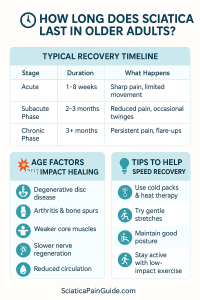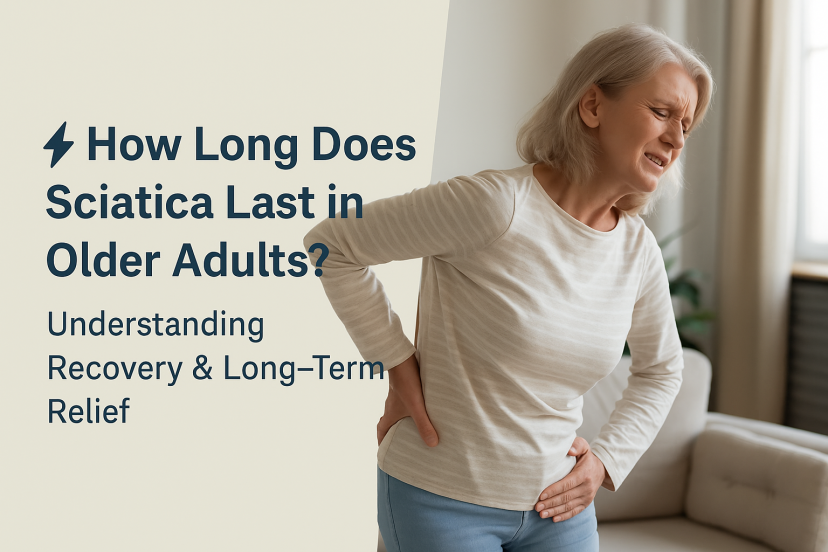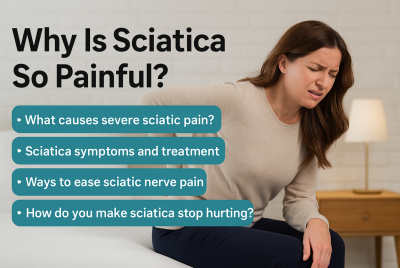How Long Does Sciatica Last in Older Adults? Understanding Recovery & Long-Term Relief
⚡ Understanding Sciatica in Older Adults
Sciatica is one of the most common causes of chronic back and leg pain among adults over 50. It occurs when the sciatic nerve — the body’s longest nerve — becomes irritated or compressed, often due to spinal wear, herniated discs, or arthritis-related changes. For older adults, the pain can be especially limiting — making it hard to walk, sit, or even sleep comfortably. But the big question remains: how long does sciatica last in older adults, and when will the pain finally fade?
Let’s break down the typical recovery timeline, what affects it, and what seniors can do to speed up healing safely and naturally.
🕐 How Long Does Sciatica Last in Older Adults?
In many cases, acute sciatica improves within 4 to 8 weeks, especially with rest, stretching, and gentle activity.
However, in older adults, recovery can take longer — sometimes 3 to 6 months — depending on underlying causes like arthritis, bone spurs, or chronic inflammation.
⏳ Typical Recovery Timeline
| Stage | Duration | What Happens |
|---|---|---|
| Acute Phase | 1–8 weeks | Sharp pain, numbness, and limited mobility |
| Subacute Phase | 2–3 months | Pain begins to ease; mild discomfort remains |
| Chronic Phase | 3+ months | Pain persists; may become constant or flare with activity |
If pain lasts longer than 12 weeks, it’s considered chronic sciatica — and often needs a combination of lifestyle changes, physical therapy, and professional care to improve.
💡 Age-Related Factors That Slow Sciatica Recovery
Older adults may face unique challenges that extend healing time:
-
Degenerative disc disease — thinning spinal discs reduces cushioning.
-
Arthritis and bone spurs — can pinch the sciatic nerve.
-
Weakened core muscles — less support for spinal alignment.
-
Poor circulation — slows nutrient delivery and nerve repair.
-
Sedentary lifestyle — limits flexibility and joint strength.
👉 The key to recovery is staying gently active — motion helps heal nerve tissue and reduces stiffness.
🧘♀️ Gentle Recovery Exercises for Older Adults
Movement is medicine for sciatica — especially low-impact routines that strengthen and stretch safely.
✅ Best Stretches for Sciatica Relief
Try these 2–3 times per day, holding each for 15–30 seconds:
-
Knee-to-chest stretch – relaxes lower back tension
-
Seated spinal twist – opens tight hips and relieves pressure
-
Pelvic tilts – strengthen core stability
-
Cat-cow stretch – improves spinal flexibility
(Always consult your doctor before starting a new exercise routine.)
🏡 Home Remedies to Speed Up Healing
Older adults can manage pain and inflammation naturally with a few daily habits.
🌿 Heat & Cold Therapy
-
Cold packs: Reduce inflammation and numb acute pain (10–15 minutes)
-
Warm compresses: Relax muscles and improve circulation (15–20 minutes)
Alternate 2–3 times a day for best results.
💺 Improve Sitting Posture
-
Use lumbar support cushions when sitting
-
Keep knees slightly lower than hips
-
Avoid sitting longer than 30–40 minutes
🛏️ Optimize Your Sleep Position
-
Lie on your side with a pillow between your knees
-
Or on your back with a pillow under your knees for spinal alignment
-
Choose a medium-firm mattress for optimal support
🧴 Anti-Inflammatory Relief Options
-
Supplements: Turmeric Curcumin, Omega-3, or Magnesium Glycinate
-
Topical creams: Menthol or arnica-based gels
-
Lifestyle: Reduce processed foods, sugar, and alcohol
💪 Recovery Treatments That Help Older Adults Heal Faster
For seniors with moderate to severe or chronic sciatica, professional therapies can dramatically shorten recovery time.
🧍 Physical Therapy
A tailored plan from a physical therapist focuses on:
-
Strengthening the lower back and core
-
Teaching safe bending and lifting techniques
-
Restoring flexibility and stability
🩻 Chiropractic Care
Chiropractors can use gentle spinal decompression or adjustments to relieve nerve compression, improve mobility, and promote natural healing.
💆 Massage & Myofascial Release
Soft tissue therapy can reduce muscle tension and inflammation in the lower back and glutes.
💊 Medication & Injections
Doctors may prescribe:
-
NSAIDs (e.g., Ibuprofen, Naproxen)
-
Corticosteroid injections for inflammation control
-
Nerve pain medications (gabapentin or pregabalin) if chronic
🧴 Helpful Products (U.S. Examples)
-
ComfiLife Lumbar Support Cushion for sitting comfort
-
Everlasting Comfort Heating Pad for targeted warmth
-
Nature’s Way Turmeric Curcumin Supplement for inflammation relief
💪 Lifestyle Changes for Long-Term Recovery
Small, consistent changes can make a big difference in how fast you heal — and prevent future flare-ups.
-
Keep moving – short daily walks improve circulation.
-
Avoid long sitting sessions – use a standing desk if possible.
-
Maintain a healthy weight – reduces spinal pressure.
-
Stretch every morning – prevents stiffness buildup.
-
Practice stress relief – chronic stress increases muscle tension.
⚠️ When to See a Doctor or Chiropractor
While most cases improve with rest and home care, seek medical attention immediately if you experience:
-
Severe or worsening pain that lasts over 8 weeks
-
Numbness or weakness in one leg
-
Loss of bladder or bowel control
-
Pain after a fall or accident
-
Sciatica combined with fever or unexplained weight loss
A doctor may recommend an MRI, physical therapy, or steroid injections, depending on the severity. Chiropractors and physical therapists can also teach safe movement patterns and alignment techniques.
❓ 7 Common FAQs About Sciatica Duration in Older Adults
1. How long does sciatica pain usually last in seniors?
Mild cases may resolve in 4–8 weeks, but older adults with arthritis or chronic conditions may need 3–6 months for full recovery.
2. Can sciatica go away on its own?
Yes — in many cases, sciatica improves naturally with movement, rest, and gentle stretching. However, chronic sciatica may need professional care.
3. What helps sciatica heal faster in older adults?
Consistent exercise, posture correction, and anti-inflammatory nutrition are key. Supplements like magnesium or turmeric may support nerve health.
4. Does walking help or hurt sciatica?
Walking helps — it boosts blood flow and reduces stiffness. Just avoid long walks that trigger pain and focus on shorter, frequent strolls.
5. Can sciatica become permanent?
Chronic sciatica can persist for months or years if nerve compression isn’t treated, but most seniors improve with consistent physical therapy and lifestyle care.
6. How can I tell if my sciatica is improving?
You’ll notice fewer pain flare-ups, better leg mobility, and less numbness or tingling over time.
7. Should older adults try chiropractic care for sciatica?
Yes, many benefit from gentle spinal adjustments and decompression therapy, especially under the care of an experienced practitioner.
🌈 Conclusion: Patience Pays Off
Healing from sciatica takes time, consistency, and self-care, especially for older adults. By combining movement, posture correction, and lifestyle improvements, most people experience steady progress and lasting relief.
Remember — every step, stretch, and healthy choice helps your body heal naturally. Don’t rush the process — your recovery is a journey, not a race.
⚕️ Medical Disclaimer
This article is for informational purposes only and should not replace medical advice. Always consult a qualified healthcare professional before starting or changing any treatment for sciatica or related conditions.






